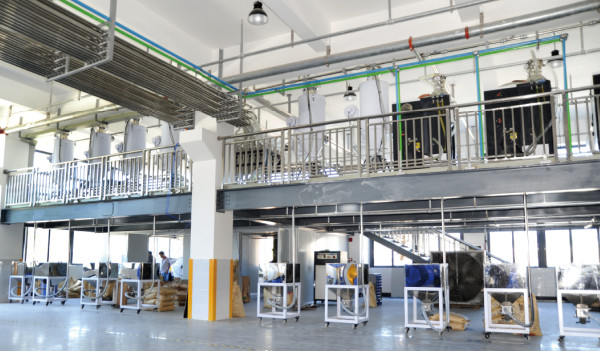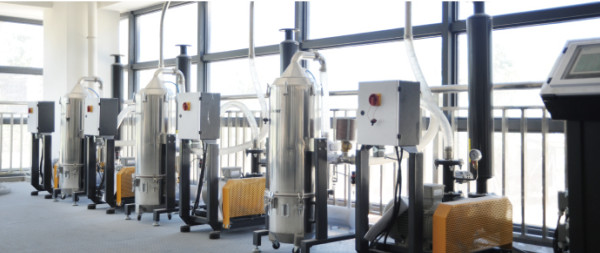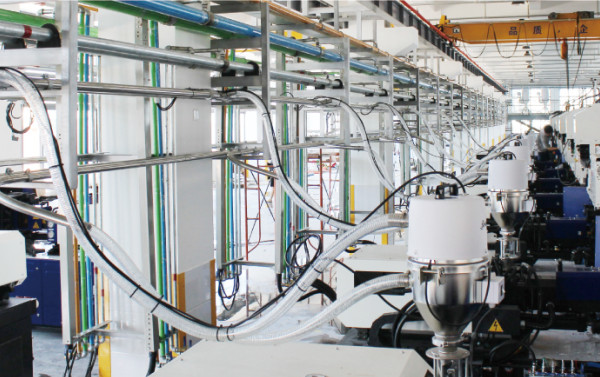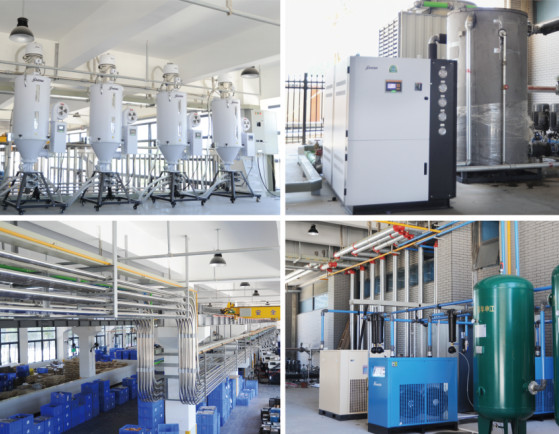Experience Sharing
Case of Plant Solution for Doors and Windows Motor Products
One company in Guangdong province is the private enterprise that specialized in design and manufacture of doors and windows motor products and related control system, which is the national high-tech enterprise with products sold overseas. The customer demanded 32 sets of interface equipments for injection molding machines. After detailed discussion and negotiation with the customer, Shini has planned this customized plant solution for it combined with her own advantages.
Central Conveying System Plan

Central conveying system is mainly designed for plastic production in injection molding workshop as to achieve uninterrupted unmanned molding production. With multi-color combination of materials, it can change the ingredient as demand to fulfill automatic coloring. The system regenerates and uses cold materials at nozzle full automatically, and controls all the conveying equipments with cluster prevention for the storage tank, achieving complete atomization through the settings on central monitor console.
This central conveying system has been designed into two injection molding lines with 32 sets of 90-160T IMMs. The customer mainly uses ABS, fireproof ABS, ABS+PC, PC+30%GF, PPS, POM6 particles, and total dosage of the plant is 7.68tons/day.
Above the platform of central conveying room, there planned with: four sets of roots blowers SRB-65-V (one for back up) for providing required airflow, three central filters SCSF-100-F for material filtration, six sets of double-layer insulated hopper dyers SHD-150SL-I for material drying, six vacuum hopper receivers SHR-12U-S on the top of dryer for material loading, six double-tube shut-off suction boxes SBU-160-38D-V for material shut-off to prevent material cooling down due to it rested on the pipe, three single-tube shut-off boxes SBU-160-38S-V installed at three sets of compact dryers SCD for material shut-off, and nine sets of dryers to convey the dried materials to the photorsensor hopper on any of the IMM via the central material distribution station SMDS-10*6-1.5”.
Below the platform of central conveying room, it’s planned with nine stainless steel storage tanks MST-100 for feeding the dryer and SCD. Overall conveying system adopts 36-station central control station SCCS-300-G-C-10.4” for central monitoring the whole conveying process. The pipeline is assembled by the method of one pipe for each machine, and each IMM is equipped with one photosensor hopper receiver SHR-6U-ES.
After systematical planning of the plant, the centralized deposited material through dust removal is far from production site, and the working condition beside the host unit improves remarkably, which increases the production efficiency and product quality, reduces manned transportation, addition and other processes, largely cutting down the labor cost. Compared with single-unit conveying equipment, the power consumption of central feeding system consumes less energy. By pipe coding and intelligent settings, it eliminates all possible human errors, and lowers the workshop temperature. Material centralized drying decreases the heat discharge in workshop, optimizes the environment in reduced working temperature and saves the space.

Water and Electricity Plan
Selection of Water-pipe Material

Although the cooling water doesn’t need filtration softening in the project, we adopt plastic steel water pipe as to ensure constant water quality for long-term operation. For pipe material, the plastic steel composite water supply pipe is made by co-extrusion with metal and plastics, so pipe intensity (rigidity) is increased. The plastics of internal wall won’t affect the water quality, while the metal of external wall can increase the stability of whole cooling system that makes up the disadvantages of the plastic pipes.
Secondly, we choose the same-course pipe solution for return loop. By adding one more pipe, it makes water supply and return cooling water go through the same course after passing the IMM to ensure consistent and stable pressure given to the equipment, and reduce the influence on equipment and finished product resulted from pressure and temperature.
Each set of injection molding machine is equipped with independent power cabinet, and indicators of voltage, current and power on the panel of machine are available for power supply observation at any time. The electricity meter inside machine records the power consumption in production, and we’ve already reserved the return loop for subsequent machine expansion of the customer, making modification and rearrangement unnecessary.
Design Highlights

The water-cooled water chiller cools down the return water in workshop by refrigerant to reach required temperature of inlet water, and the LIANG CHI cross-flow square cooling tower features strong cooling capacity, less water splash, low noise, great intensity that easy of assembly and maintenance.
The hot water returned from workshop is cooled down after passing through the chiller, and the top chilled water enters the tank and is mixed at the upper layer firstly. At the bottom, one end of the lower temperature water is conveyed to water chiller for cooling, and the other end is pumped to the workshop. The water chiller can suspend for a while after a period of work as the capacity of water tank is sufficient.
Water tower is placed above the pre-set water pool, and return water finally enters the water pool after it cooled down by cooling tower for storage. As water temperature at the bottom is lower than the top, so pumping of the bottom water to workshop features better cooling performance.
All return loops are constructed as national design specifications, and proper distance has been left between the pipes made of qualified materials, which achieved one-to-three way effect by layered layout and full use of the space diversities.
In the development of Shini, we’ve offered numerous optimum plant solutions with strict requirement for each process in the planning of storage, distribution, conveying, molding, water and electricity, and are dedicated to making innovation for the excellence. In the future, our professional team will continue to provide perfect products and services for more customers with solid technologies and rigorous attitude. Now, we’ve launched the sfactory 4.0 smart plant by combining our experiences and advantages with the intelligent development trend.
Experience Sharing
- Case of Shini Mold Temperature Controller and Data Acquisition System
- Case of Central Conveying System in Package Industry
- Case Studies - Automation Application in Electrical Appliances Industry
If you want to read other articles, back to2018 Quarter 1 Issue 34.
